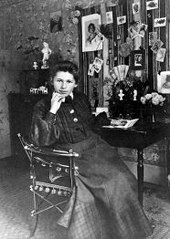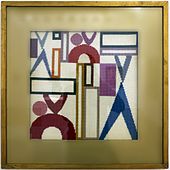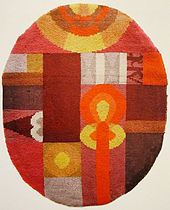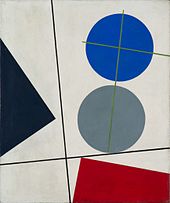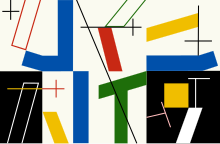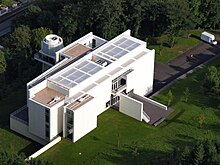Sophie Taeuber-Arp
Sophie Taeuber-Arp Henriette Gertrud (* 19th January 1889 in Davos as Sophie Taeuber Henriette Gertrude ; † 13. January 1943 in Zurich ) was a Swiss painter , sculptor , textile designer , architect and dancer of the avant-garde . As a representative of concrete , rhythmic-geometric art, she is an important artist of the 20th century. She is one of the protagonists of Dadaism .
Life
Childhood and youth
Sophie Taeuber was born in Davos- Platz as the fifth child of the pharmacist Emil Taeuber from Prussia and his wife Sophie Taeuber-Krüsi, an Appenzeller from Gais , as German . After the father's untimely death - he died of tuberculosis when the daughter was two years old - the mother took Swiss citizenship for herself and the daughter and moved with her to Trogen , where she worked in the “ Pension Taeuber ”grew up.
From 1906 to 1910 Taeuber studied at the textile department of the École des arts décoratifs in St. Gallen , then from 1910 to 1914 art and design at the Debschitz School in Munich and Hamburg . In 1914 she moved to Zurich .
Expressive dance
In addition to her work as a craftsperson , she began dance training with Rudolf von Laban and his assistant Mary Wigman in Zurich in 1915 . For several summers she danced with the Laban group at the artists' colony on Monte Verità above Ascona . She danced there together with Mary Wigman, Katja Wulff , Suzanne Perrottet and others at the big "Sun Festival" staged by Rudolf von Laban in August 1917. Taeuber performed several times as an expressive dancer within the DADA Zurich, sometimes as part of a Laban dance group . Two solo appearances in DADA events are documented, one of them at the opening of the DADA gallery on March 29, 1917.
Zurich School of Applied Arts
From May 1916 Taeuber headed the textile class at the Zurich School of Applied Arts. Until 1929 she taught with the aim of combining art, design, craft and everyday life in a creative way, removing the boundaries between the genres. Sophie Taeuber was relatively unaffected by the anti-rational of Dada. In the words of Max Bill, “she tried to give her students an understanding of the problems of the time so that they did not slip into pointless craftsmanship.” Her activity as a teacher formed the financial basis for her and Hans Arps for around 12 years Livelihood.
Dada and Constructive Art
During the period of the First World War , in which Switzerland remained neutral, Sophie Taeuber joined the Swiss Werkbund in 1915 , of which she was a member until 1932. She met Hans Arp at an exhibition in the Tanner Gallery . Both rejected traditional art forms and materials and looked for alternatives. Taeuber and Arp began to work together with elementary forms, at the same time their friendship intensified. Hans introduced Sophie to the Dadaist circle .
On February 5, 1916, the artists' pub Cabaret Voltaire opened in Zurich under the direction of Hugo Ball and with the collaboration of Emmy Hennings , Tristan Tzara , Marcel Janco , Richard Huelsenbeck , Hans Arp and other like-minded artists. “Dada” was developed there in artistic performances (poetry recitations, cabaret, readings, singing, dance, concerts, exhibitions), conversations and the way of life. Sophie Taeuber performed as an expressive dancer at Cabaret Voltaire. For the opening of the "Galerie Dada" founded by Emmy Hennings in March 1917, she danced to verses by Ball and in a shamanic mask by Marcel Janco. A year later she was a signatory to the Dadaist Manifesto in Zurich. In 1918 the first of their famous "Dada heads" was created.
By working with textile weaving, she came to new forms of expression: As early as 1915 Taeuber was painting completely non-representational (not abstracting) pictures with her “vertical-horizontal compositions”. These are among the first concrete / constructive works of art of modernism and were created around the same time as those by Piet Mondrian and Kasimir Malewitsch . Today Sophie Taeuber is considered a pioneer of constructive and concrete art and as the initiator of the movement of constructive / concrete art in Zurich (which was developed at the same time, primarily in Russia by the Russian avant-garde and in the Netherlands by the De Stijl group ). Both expressive dance and constructive art became part of DADA Zurich through Sophie Taeuber.
Puppet theater
In 1918 the exhibition of the Swiss Werkbund took place in Zurich. In this context, Taeuber was commissioned by Alfred Altherr (director of the Kunstgewerbeschule and the Kunstgewerbemuseum Zurich) to stage and furnish the play König Hirsch by Carlo Gozzi - in the modern adaptation by René Morax. Her case created stage sets and puppets , the Cubist sets and costumes can Picassos for Cocteau's libretto for the ballet Parade in 1917 and Triadic Ballet by Oskar Schlemmer be set in 1922 in relationship. The Wachen puppet satirizes the militarism of futurism and can be described as the first figuration of a "robot". The marionettes are now in the collection of the Museum für Gestaltung Zürich , in the Toni area of the Zurich University of the Arts (ZHdK).
Quote from Klaus Minges: “Sophie Taeuber pursued the goal of the Dadaists, the destruction of imperial culture with means that are just as radical as the war, also in a subtle way in the puppets; it cannot be denied that a subversive force emanates from their staging. The inhuman nature of the characters, the absurdity of a state made up of short-lived drones and faceless military personnel does not seem to have escaped the audience. The Zurich daily press is silent about the premiere on September 11, 1918. The piece disappeared from the repertoire, the second performance did not take place until 1965 in St. Gallen. The game from 1918 is a singular phenomenon in Taeuber's work, as its figurative element remained rather alien. But it is precisely in the marionettes that one can see how complex sculptures can be developed from the simplest principles of design with horizontal and vertical lines. Constructivism and concrete art are happily combined with elements of the surreal. "
Her contact and exchange with artists and writers was still lively at that time. In the summer of 1922, for example, they met Max Ernst , Paul and Gala Éluard and Tristan Tzara in Tyrol .
Marriage to Hans Arp
On October 20, 1922, Sophie Taeuber and Hans Arp married in the small Ticino town of Pura . They spent their next summer vacation with Kurt Schwitters and Hannah Höch on the island of Rügen .
The years in Strasbourg and Paris
In 1926 the Arps moved to Strasbourg , where both took French citizenship. Sophie Taeuber-Arp continued to work at the applied arts school in Zurich until 1929. Taeuber received numerous orders for interior design in Strasbourg. Her first big project was the wall design of the Hotel Hannong. In 1926, Taeuber was commissioned by André and Paul Horn to design the Aubette , a multifunctional entertainment center with a cinema, dance hall, restaurant, tea room and bar on Place Kléber in Strasbourg . She brought in Hans Arp and her artist and architect friend Theo van Doesburg . They worked together at the Aubette until 1928. Commuting between Zurich, Paris and Strasbourg was very stressful for her, and a stay at a health resort was necessary. She spent him with a lung disease with Gala and Paul Éluard in Arosa . With the proceeds from the Aubette order, the Arps built a house in Meudon / Clamart near Paris. Sophie Taeuber-Arp designed the architecture, garden design and furniture in her home and studio.
Sophie Taeuber and Hans Arp were members of the Parisian artists' association “ Cercle et Carré ” and the subsequent association “ Abstraction-Création ”. During this time her long-term friendship with the painter couple Sonia Terk and Robert Delaunay was strengthened . Wassily Kandinsky , who had emigrated to France with his wife Nina in 1933, became friends with the Arps; Joan Miró , Wolfgang Paalen , Florence Henri , Kurt Schwitters and Marcel Duchamp were also among her circle of friends. The Arps now exhibited more and more and created a basis for themselves within the abstract-constructivist avant-garde . The years 1936–1939 were Sophie Taeuber's happiest and most intensive work phase, during which time she created around 117 works.
Plastique / PLASTIC magazine
The trilingual art magazine plastique / PLASTIC was founded in 1937 by the US collector and painter Albert Eugene Gallatin, the Dutch-born artist César Domela, who lives in Paris, the US artist George LK Morris and Sophie Taeuber-Arp, who is the publisher of the booklet acted. The magazine appeared in French, English and German in Paris and New York and was intended to make non-objective, constructive art better known. plastique / PLASTIC promoted cooperation and exchange between European and US-American constructive artists and those interested in this art, such as patrons and collectors. The journal's authors were a number of artists and art theorists; Hans Arp also brought in poems by artists. Sophie Taeuber-Arp fulfilled the central tasks: editing, correspondence with international artists from whom she asked for contributions, design / layout, control of printing, distribution. Taeuber-Arp was continuously concerned with promoting the development of constructive-concrete art, making it more widely known and supporting the artists in this atmosphere that was politically hostile to avant-garde art in Europe. Five editions appeared by 1939 - then the war made it impossible to continue.
War years and escape
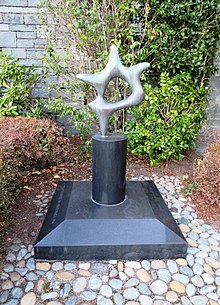
The occupation of France by the National Socialists in 1940 forced the couple to leave Clamart. While fleeing from the occupiers, Peggy Guggenheim gave them temporary shelter. In Grasse in the south of France , the couple worked a. a. together with Sonja Delaunay-Terk . In Grasse, Arps suffered from poverty and malnutrition and were dependent on food parcels from Switzerland, which Sophie's sister Erika Schlegel and the art collector Marguerite Hagenbach sent them. Sophie Taeuber-Arp continued to work intensively as an artist. a. an extensive series of complex compositions - colored pencil drawings which she referred to as "Lignes géometriques et ondoyantes" (paint or canvases for oil paintings were now hardly available). Despite partial isolation, the Arps continued to take part in exhibitions in Europe. Before the National Socialists marched into Grasse, they fled to Zurich, Switzerland. Sophie Taeuber-Arp spent her last New Year's party in 1942/43 in Max Bill's house in Zurich- Höngg . She died on the night of January 13, 1943, of carbon monoxide poisoning from a mishandled stove in the Bill's house. She found her final resting place in a shared grave with Hans Arp and Marguerite Arp-Hagenbach in a cemetery in Locarno .
Work and reception
The pictures and sculptures Taeuber-Arps and their applied works (building sculpture, carpets and furnishings) brought her fame only posthumously . They belong to the concrete , also called constructive art. Vertical-horizontal compositions of triangles, rectangles, circles, wavy elements, straight and curved lines were her repertoire of forms. The figures (people, birds), which were initially still recognizable, soon disappeared completely from their pictures and reliefs. Her consciously simple design elements achieve a floating balance of colors and shapes that often appears to be dancing and moving. In contrast to the constructivism of Piet Mondrian or Georges Vantongerloo , the way of working, which tends towards objectification, is often absorbed by a deep intimacy of the colors and by formal “deviations” from systematic patterns that appear humorous.
“It was Sophie Taeuber who showed me the right path, the path to beauty, through the example of her clear work and her clear life. In this world there are above and below, brightness and darkness, eternity and transience in perfect balance. So the circle came full. "
In the public consciousness, Sophie Taeuber, like many women in art , for a long time appeared little behind her much better-known husband Hans (Jean) Arp . Nevertheless, she was able to exhibit her works together with those of the most important Constructivists, mostly as the only woman. Their early DADA heads, turned sculptures with geometrically painted faces, are known. Many museums worldwide have individual pictures, drawings, gouaches or wooden reliefs by Sophie Taeuber-Arp in their collections.
Sophie Taeuber only became famous after the Second World War. Some of her works were exhibited at documenta 1 in 1955. In the course of the renaissance of Classical Modernism , her work is now widely recognized and shown in museums and extensive exhibitions. Taeuber-Arp was the only woman depicted on a Swiss banknote: the 50-franc note valid from 1995 to 2016 showed her portrait. The Arp Museum Bahnhof Rolandseck was opened on September 29, 2007 in the Remagen district of Rolandseck . It presents works by Hans Arp and Sophie Taeuber-Arp in the Rolandseck station building and in a new building. The Fondazione Marguerite Arp, with its headquarters and exhibition space in Locarno- Solduno, is also concerned with preserving the heritage of the artist couple. In her video work “Sophie Taeuber-Arps Fluchtlinien” (2015), the Luxembourg-Swiss media artist Myriam Thyes deals with Taeuber-Arp's “Lignes” group of works, ink drawings with segments crossed by lines that were created in her exile in southern France (1940–1942) originated.
Fonts
- With Blanche Gauchat: Instructions for teaching textile professions. Edited by the Zurich City Trade School. Zurich 1927.
- Notes on the instruction in ornamental design . In: Swiss correspondence sheet. Association of trade and home economics teachers. No. 11/12. Vol. 14 pp. 156-159.
- Sophie Taeuber published the French-American magazine Plastiques-plastic, Paris - New York between 1937 and 1939 , of which a total of 5 issues were published. Regular employees of the magazine were Hans Arp and Sophie Taeuber himself, the painter, typographer and photographer Cesar Domela (1900–1992), the art collector Albert Eugene Gallatin (1881–1952) and the American art critic George LK Morris (1905–1975).
- In 2012, the Zurich Central Library purchased around 450 unpublished letters and postcards from Sophie Taeuber-Arp from the years 1905–1942. They are currently being processed in a research and publication project at the Zurich University of the Arts under the direction of Prof. Sigrid Schade . In 2017 they will be published in 3 volumes by Nimbus-Verlag
Exhibitions (selection)
- 1936: Time problems in Swiss painting and sculpture , Kunsthaus Zürich.
- 1937: Constructivists . Kunsthalle Basel . In this group exhibition, 24 works by Sophie Taeuber-Arp were shown.
- 1981: Sophie Taeuber-Arp . Museum of Modern Art , New York. Catalog
- 1983: Sophie Taeuber . Museo Communale, Ascona, Bottrop Square , Bottrop
- 1989: Sophie Taeuber-Arp, Hans Arp. Artist couples - artist friends . Kunstmuseum Bern , Hans Arp and Sophie Taeuber-Arp Foundation, Rolandseck , Von der Heydt Museum , Wuppertal. Catalog
- 1994: Sophie Taeuber-Arp (1889-1943). Municipal gallery in the Lenbachhaus and Kunstbau, Munich
- 2003: Sophie Taeuber-Arp. Variations. Solothurn Art Museum , Solothurn
- 2006: Jean Arp & Sophie Taeuber-Arp. Dada e oltre. Museo Correr Venice
- 2007: Sophie Taeuber-Arp. Designer, architect, dancer . Museum Bellerive , Zurich
- 2007: Sophie Taeuber, Rythmes plastiques, réalités architecturales , Fondation Arp, Clamart
- 2008: Light on Arp. Works by Hans Arp and Sophie Taeuber Arp from the collection of the State of Rhineland-Palatinate.
- 2009: Sophie Taeuber-Arp. Camminos de vanguardia. Museo Picasso , Málaga
- 2009: movement and balance . Sophie Taeuber-Arp 1889–1943. Kirchner Museum in Davos; Arp Museum Bahnhof Rolandseck, Remagen. Catalog ISBN 978-3-86678-320-1
- 2011–2012: The other side of the moon . Avant-garde artists. North Rhine-Westphalia Art Collection , K20, Düsseldorf. Catalog: DuMont Verlag, 2011
- 2014: Sophie Taeuber-Arp - Today is tomorrow . Aargauer Kunsthaus , Aarau, Switzerland
- 2016: ZweiKlang - Sophie Taeuber and Hans Arp . Municipal gallery Bietigheim-Bissingen
- 2021: Sophie Taeuber-Arp - Living Abstraction . Museum of Modern Art , New York
literature
- Annemarie Bucher: Sophie Taeuber-Arp. In: Historical Lexicon of Switzerland . May 14, 2012 , accessed December 5, 2019 .
- Elke Krafka: Sophie Taeuber-Arp . In: Andreas Kotte (Ed.): Theater Lexikon der Schweiz . Volume 3, Chronos, Zurich 2005, ISBN 3-0340-0715-9 , p. 1787 f.
- Angela Thomas Jankowski: sophie taeuber-arp. 1889–1943 (exhibition catalog). Buchs: Waser, 1983. (Catalog design: Max Bill.)
- Angela Thomas: With an undisguised look. Report on three artists: Anna Baumann-Kienast, Alis Guggenheim, Sophie Taeuber-Arp . Bern: Benteli Verlag, 1991. (Catalog design: Max Bill.) ISBN 3-7165-0807-1 .
- Sophie Taeuber-Arp 1889–1943 . Catalog for the exhibition in the Arp-Museum Bahnhof Rolandseck, in the Kunsthalle Tübingen (both 1993), in the Städtische Galerie im Lenbachhaus Munich (1994). Ed .: Siegfried Gohr , Verlag Gerd Hatje, Stuttgart 1993. ISBN 3-7757-0419-1
- Gabriele Mahn: Sophie Taeuber-Arp , pp. 160–168, in: Karo Dame , book for the exhibition Karo Dame. Constructive, concrete and radical art by women from 1914 to today , Aargauer Kunsthaus Aarau, publisher: Beat Wismer , Lars Müller publishing house, Baden 1995. ISBN 3-906700-95-X
- Variations. Sophie Taeuber-Arp. Works on paper . Book for the exhibition in the Art Museum Solothurn. Ed .: Christoph Vögele. Kehrer Verlag, Heidelberg 2002. ISBN 3-933257-90-5
- Sophie Taeuber-Arp - designer, architect, dancer . Catalog for the exhibition in the Museum Bellerive, Zurich. Ed .: University of Design and Art Zurich. Scheidegger & Spiess Verlag, Zurich 2007. ISBN 978-3-85881-196-7
- Movement and balance. Sophie Taeuber-Arp 1889–1943 . Book for the exhibition in the Kirchner Museum Davos and in the arp museum Bahnhof Rolandseck. Ed .: Karin Schick, Oliver Kornhoff, Astrid von Asten. Kerber Verlag, Bielefeld 2010. ISBN 978-3-86678-320-1 .
- Susanne Meyer-Büser: Two avant-garde networkers in Paris around 1930. In the footsteps of Florence Henri and Sophie Taeuber-Arp , in: The other side of the moon. Avant-garde artists . Book for the exhibition in the Kunstsammlung Nordrhein-Westfalen, Düsseldorf (ed.), And in the Louisiana Museum of Modern Art, Humlebaek, Denmark. DuMont Buchverlag, Cologne 2011. ISBN 978-3-8321-9391-1 .
- Roswitha Mair: craft and avant-garde. The life of the artist Sophie Taeuber-Arp . Parthas Verlag Berlin 2013. ISBN 978-3-86964-047-1 .
- Sophie Taeuber-Arp - Today is tomorrow . Comprehensive publication on the exhibition in the Aargauer Kunsthaus, Aarau, and in the Kunsthalle Bielefeld. Ed .: Thomas Schmutz and Aargauer Kunsthaus, Friedrich Meschede and Kunsthalle Bielefeld. Scheidegger & Spiess Verlag, Zurich 2014. ISBN 978-3-85881-432-6
- Ina Boesch : The DaDa. How women shaped Dada. Scheidegger and Spiess, Zurich 2015. ISBN 978-3-85881-453-1 .
- Rahel Beyerle: The line in focus. A line quartet Sophie Taeuber-Arps in a theoretical context , master's thesis in art history, Philosophical Faculty of the University of Zurich, 2015.
- Margret Greiner : Sophie Taeuber-Arp: Der Umriss der Stille , novel biography, Basel, Zytglogge, 2018, ISBN 3-7296-5002-5 .
- Mona de Weerdt, Andreas Schwab (ed.): Monte Dada. Expressive dance and avant-garde , Stämpfli Verlag, Bern 2017. ISBN 978-3-7272-7937-9 .
Movie
- Christoph Kühn: Sophie Taeuber-Arp , documentary, ventura film 1993, 44 min.
- Marina Rumyantseva: A well-known stranger. Sophie Taeuber Arp, documentary, SRF / 3sat 2012, 52 minutes
Web links
- Literature by and about Sophie Taeuber-Arp in the catalog of the German National Library
- Materials by and about Sophie Taeuber-Arp in the documenta archive
- Fem biography
- Klaus Minges: State-building insects. Sophie Taeuber's marionettes for “King Deer” in the Museum Bellerive Zurich
- arp foundation : Sophie Taeuber-Arp, biography and further links
- Biography on the Arp Museum website ( Memento from February 3, 2014 in the Internet Archive )
- The Arp Foundation in Meudon / Clamart in the former home of Taeuber and Arp (French)
- The Arp Museum Bahnhof Rolandseck
- Art aspects exhibitions and further links
- SRF-Dok: A well-known stranger, Sophie Taeuber-Arp from Appenzell
- Anette Schneider: deutschlandfunk.de: Art as a matter of course ; Deutschlandfunk , calendar sheet , January 19, 2014
- Kultur Online via the Sophie Taeuber-Arp retrospective . Today is tomorrow in the Aargauer Kunsthaus and in the Kunsthalle Bielefeld, 2014–2015
- Fondazione Marguerite Arp Foundation of the art collector Marguerite Hagenbach, second wife of Hans Arp
- Elisabeth Grossmann: Taeuber-Arp, Sophie Henriette Gertrud. In: Sikart
- Online exhibition on the website of Galerie Hauser & Wirth (accessed on August 10, 2020)
Individual evidence
- ↑ Thomas Krens (preface): Rendezvous. Masterpieces from the Center Georges Pompidou and the Guggenheim Museums . Guggenheim Museum Publications, New York 1998, ISBN 0-89207-213-X , p. 694
- ↑ a b biography ( memento from July 18, 2012 in the web archive archive.today ) on sophie-taeuber-arp.com
- ^ Sophie Taeuber-Arp as a dancer and Dadaist. A wish from the reception? by Walburga Krupp in: Monte Dada , eds. Mona De Weerdt and Andreas Schwab, Stämpfli Verlag, Bern 2017
- ↑ Archived copy ( Memento of the original from July 14, 2014 in the Internet Archive ) Info: The archive link was inserted automatically and has not yet been checked. Please check the original and archive link according to the instructions and then remove this notice.
- ↑ Gabriele Mahn, Sophie Taeuber-Arp , pages 160–168, in: Karo Dame , book for the exhibition Karo Dame. Constructive, concrete and radical art by women from 1914 to today , Aargauer Kunsthaus Aarau, publisher: Beat Wismer, Lars Müller publishing house, Baden 1995. ISBN 3-906700-95-X
- ^ Sophie Taeuber: The Masked Dada Dancer , oxfordjournals.org, accessed February 4, 2011
- ↑ Astrid von Asten, Karin Schick (ed.): Movement and balance - Sophie Taeuber-Arp 1889-1943 . Bielefeld: Kerber Verlag, 2009; ISBN 978-3-86678-320-1
- ^ Klaus Minges: State-building insects
- ↑ Reopening of the Aubette , art-is-art.com, accessed on February 4, 2011
- ^ Isabelle Ewig, Thomas W. Gaehtgens, Matthias Noell: The Bauhaus and France 1919–1940 / Le Bauhaus et la France . Akademie-Verlag, 2002, ISBN 978-3-05-003720-2 , p. 420
- ↑ Maike Steinkamp: In the network of modernity. Sophie Taeuber-Arp's commitment to the magazine Plastique , pp. 233–239, in: Sophie Taeuber-Arp. Today is tomorrow , Verlag Scheidegger & Spiess, Zurich 2014
- ↑ Roswitha Mair: Plastique , pp. 243–245. In: craft and avant-garde. The life of the artist Sophie Taeuber-Arp . Parthas Verlag, Berlin 2013, ISBN 978-3-86964-047-1 .
- ^ Fondazione Marguerite Arp
- ↑ See weblink Biography Sikart
- ↑ Reinhard Döhl: Eva Anna Sophie or from the Muse des Experiments netzliteratur.net, accessed on February 3, 2011
- ↑ Swiss National Bank (SNB) - Eighth series of banknotes 1995. Accessed on October 22, 2017 .
- ↑ Exhibition 100 Years of World Transition in the foam bath Atelierhaus Graz , accessed on October 27, 2016
- ↑ Constructions of artistry and creativity in self-testimony: Letter edition Sophie Taeuber-Arp ( Memento of the original of 23 August 2016 in the Internet Archive ) Info: The archive link was inserted automatically and has not yet been checked. Please check the original and archive link according to the instructions and then remove this notice.
- ↑ Concrete Art. Manifestos and artist texts, edited by Margit Weinberg Staber, Zurich, 2001.
- ↑ Images from the exhibition catalog
- ↑ Brigitte Maier: In the cauldron of the avant-garde. Sophie Taeuber-Arp and the Constructivist Exhibition 1937 , pp. 240–246, in: Sophie Taeuber-Arp. Today is tomorrow , Verlag Scheidegger & Spiess, Zurich 2014
- ↑ Irene Netta, Ursula Keltz: 75 years of the Städtische Galerie im Lenbachhaus and Kunstbau Munich. Ed .: Helmut Friedel. Self-published by the Städtische Galerie im Lenbachhaus and Kunstbau, Munich 2004, ISBN 3-88645-157-7 , p. 226 .
- ^ [1] Sophie Taeuber-Arp in Sternstunde Kunst on SRF on December 29, 2012
| personal data | |
|---|---|
| SURNAME | Taeuber-Arp, Sophie |
| ALTERNATIVE NAMES | Taeuber-Arp, Sophie Henriette Gertrud (full name); Taeuber, Sophie Henriette Gertrud (maiden name) |
| BRIEF DESCRIPTION | Swiss painter and sculptor |
| DATE OF BIRTH | January 19, 1889 |
| PLACE OF BIRTH | Davos |
| DATE OF DEATH | January 13, 1943 |
| Place of death | Zurich |
